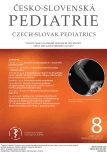Genu recurvatum congenitum
Authors:
L. Kubalík 1; R. Jeník 1; M. Rafi 2
Authors place of work:
Dětské oddělení, Kroměřížská nemocnice, a. s., Kroměříž
1; Ortopedické oddělení, Kroměřížská nemocnice, a. s., Kroměříž
2
Published in the journal:
Čes-slov Pediat 2021; 76 (8): 453-459.
Category:
Kazuistika
Summary
Genu recurvatum congenitum is a rare congenital disease. Its essence is excessive hyperextension of knee with limited flexion, optionally in combination with subluxation or dislocation of the femoral condyle to the tibia. The aetiology is not clearly clarified, congenital positional deformities and congenital connective tissue disorders are reported. The co-occurrence with other congenital malformations of the musculoskeletal system (dysplasia of hip joint, abnormities of foot under the ankle) is also common. The diagnosis is based on a somatic finding, ultrasound imaging (especially contracture and / or quadriceps fibrosis) and X-ray (exclusion of dislocation in joint or traumatism) are made. In more severe cases, more complex musculoskeletal abnormalities are present, it is advisable to look at least clinically for other congenital defects, syndromological units may be present. A conservative approach prevails in management – we start splinting and casting of the knee in a neutral position on the day of delivery. Depending on the flexion achieved, we continue conservatively or consider an indication for surgical solution. That is also reserved for primarily more severe cases of defects and also if the defect was detected at a later age. For milder forms of defect and early healing, the prognosis is excellent, in other cases the results are individual, walking mechanism impairment may persist. Most patients require regular dispensarization. In the case report, we will talk about a newborn from our hospital, that is a typical example of a mild form of this defect.
Keywords:
genu recurvatum congenitum – back knee – knee hyperextension
Zdroje
1. Mehrafshan M, Wicart P, Ramanoudjame M, et al. Congenital dislocation of the knee at birth – Part I: Clinical signs and classification. Orthop Traumatol Surg Res 2016; 102 (5): 631–633.
2. Omololu B, Ogunlade SO, Alonge TO. Congenital dislocation of the knee in Ibadan, Nigeria. WJM 2002; 21 (4): 307–309.
3. Kamata N, Takahashi T, Nakatani K, Yamamoto H. Ultrasonographic evaluation of congenital dislocation of the knee. Skeletal Radiol 2002; 31 : 539–542.
4. Abdelaziz TH, Samir S. Congenital dislocation of the knee: a protocol for management based on degree of knee flexion. J Child Orthop 2011; 5 : 143–149.
5. Es-Seddiki A, Nkhili H, Amrani R. Le genu recurvatum congénital: une situation rare en salle de naissance. Á propos de deux cas. Rev Méd Périnat 2016; 8 (1): 54–57.
Štítky
Neonatológia Pediatria Praktické lekárstvo pre deti a dorastČlánok vyšiel v časopise
Česko-slovenská pediatrie

2021 Číslo 8
- Gastroezofageální reflux a gastroezofageální refluxní onemocnění u kojenců a batolat
- Využití hodnoticích skóre a objektivních nástrojů při léčbě astmatu
- Aktuálne možnosti terapie chronickej zápalovej demyelinizačnej polyradikuloneuropatie (CIDP)
- Rizikové období v léčbě růstovým hormonem: přechod mladých pacientů k lékařům pro dospělé
Najčítanejšie v tomto čísle
- Současné pohledy na patofyziologii, diagnostiku a léčbu imunitní trombocytopenie v dětském věku
- História invazívneho merania tlaku krvi
- Genu recurvatum congenitum
- Imunitní trombocytopenie – zkušenosti jednoho centra
